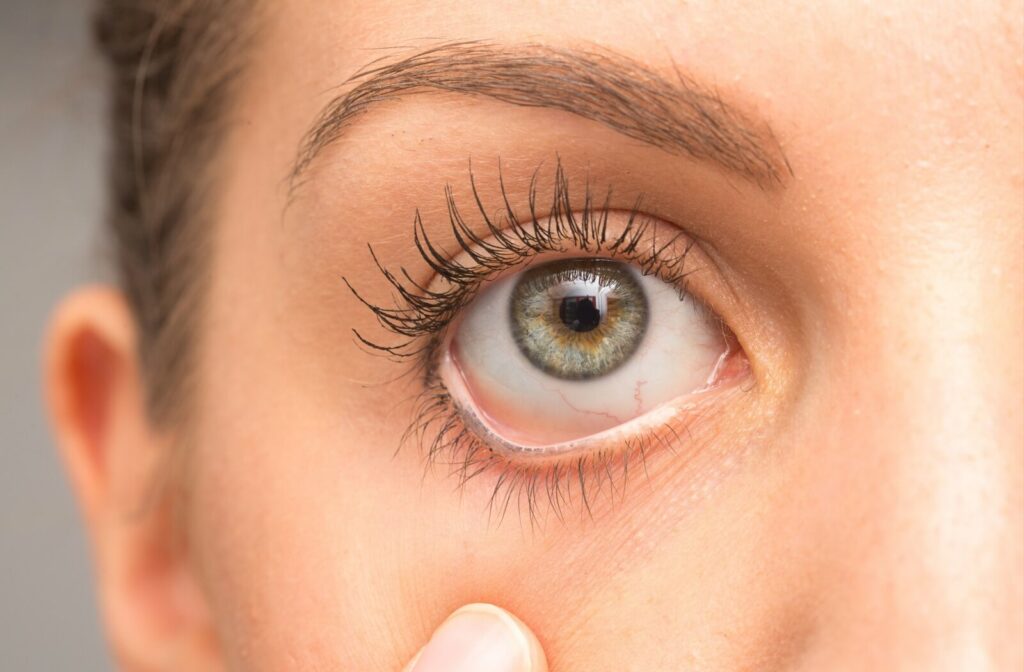Dry, gritty, burning eyes—these are tell-tale signs of dry eyes. This is a lot more common than most people think, disrupting the flow of your day, and can be caused by anything from environmental factors to hormonal changes. However, one of the most common causes of dry eye—especially evaporative dry eye—is a clog in the meibomian glands of your eyelid. So how do you unclog meibomian glands?
If you’re dealing with dry eyes, start with warm compresses. These can help loosen up any oil blockages in the area, and can often help you find relief. Longer term it helps to make sure you’re following a balanced diet rich in fruits and vegetables to give your tears what they need to create a healthy tear film. However, if you’re often dealing with dry and irritated eyes, visit your optometrist to discuss dry eye therapy.
What Are Meibomian Glands?
Every time you blink, you disperse a thin layer of tears over the surface of the eye. These tears help protect your eye, making it easier to flush away any contaminating particles, all while keeping the eye hydrated and nourished.
To properly protect your eyes, the tear film needs three key components:
- Water
- Mucus
- Oils
Together, these three layers form a stable tear film. The last layer, the oils, is an extremely important part—it prevents the tear from evaporating too early while keeping the outside layer smooth and clear, allowing light to refract properly into the eye without obstruction.
These oils are produced in the meibomian glands, the tiny glands spread throughout the eyelid. They funnel oils into the tear film to keep it protected. But what happens if you have a problem with these glands?
What Is Meibomian Gland Dysfunction?
To properly do their job, these glands need the oils to reach the tear film. Otherwise, the eyes are unprotected. It’s vulnerable to early evaporation and more, which can set off a chain reaction of further symptoms.
Sometimes, these glands can become blocked or obstructed in some way. They can limit, or entirely cut off, the oils from reaching the tear film. When this happens, your tear film is no longer protected; it can evaporate and disperse, leaving the eye vulnerable.
This is called “meibomian gland dysfunction,” or MGD, and it’s the leading cause of evaporative dry eye. This is an extremely common eye condition. It can be caused by plenty of factors, such as:
- Getting older
- Hormonal changes, particularly during menopause
- Wearing contact lenses for extended periods
- Environmental factors, such as exposure to dry air or wind
It’s essential to learn how to recognize the symptoms of MGD and dry eye. It isn’t just about temporary discomfort; it leaves the eyes exposed and vulnerable. They can no longer easily flush away damaging particles, and they’re more at risk of damage and scratches. So what are the symptoms of meibomian gland dysfunction?
The Symptoms of Meibomian Gland Dysfunction
When you’re trying to determine if you’re dealing with MGD, the most obvious sign is dry, burning, and irritating feelings on the surface of your eye. It often feels almost as if there’s a small piece of sand trapped under the eyelid irritating your eye every time you blink.
Other common symptoms include:
- Sore or stinging eyes
- Burning sensations
- Excessive tearing (as the eyes attempt to compensate for dryness)
- Contact lens discomfort
- Light sensitivity
If you notice any of these signs, it could be a problem in those glands.
How to Treat Meibomian Gland Dysfunction
There is good news, though—you don’t need to suffer needlessly from MGD and dry eyes. Instead, you can take some preventative steps to protect your eyes and vision. At Fontana Optometric Group, we typically recommend the following for dry eye therapy:
- Using warm compresses for initial comfort
- Use eye drops during flare-ups to find temporary relief
- Antibiotic or anti-inflammatory medications
- Practice good eyelid hygiene to remove bacterial buildup
In many cases, we will advise a treatment called “meibomian gland expression.” This is an in-office treatment designed to help break down clogs and blockages in the meibomian glands.
To do this, we use an extremely gentle amount of pressure on the upper and lower eyelids, right near the eyelashes. This helps to slowly break up any blockages in the area, removing the clogs from the glands. This allows oils to flow freely to the tear film again, which can help restore the balance of your tear film.
Once the blockages are removed, your tear film will once again be properly protecting your eyes. Your symptoms of MGD and dry eyes should soon go away!
Get Help for Your Dry Eyes
If you’re dealing with dry, burning, and irritated eyes, come see our team at Fontana Optometric Group to discuss dry eye therapy. We can examine your eyes and find the right treatment for you. You don’t deserve to deal with dry eyes alone, so book an appointment with our team, and take the first step towards finding relief!


